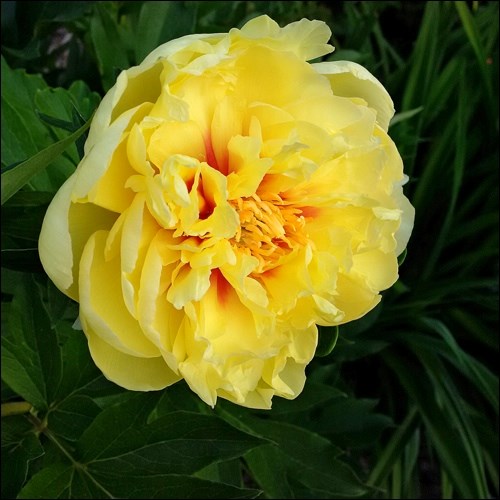Itoh peonies, a hybrid combining the hardiness and habit of herbaceous peonies with the colour range, flower size and extended flowering period of the tree peonies, are a relative newcomer to the prairies. Initially not thought to be hardy, several climate-zone deniers in Saskatoon and elsewhere on the prairies have shown again that plants, not labels, are the best arbiters of what is truly hardy.
The story of their development is one of persistence and tenaciousness on the part of their first breeder, Dr. Toichi Itoh (pronouced Ee-toe), a Japanese nurseryman and plant breeder. His goal: to create a pure yellow herbaceous peony. Dr. Itoh pollinated more than 1,200 peony plants before obtaining 36 seedlings in 1948 when he successfully crossed the yellow hybrid tree peony,Alice Harding, with a double-flowered, white herbaceous peony, Kakoden.
Nine of these resembled tree peonies while 27 had characteristics of herbaceous peonies. Sadly, he died in 1956 before any of them came into flower. His son-in-law, Shiagao-Oshida, continued his work and four plants were selected for introduction: Yellow Crown, Yellow Emperor, Yellow Dream and Yellow Heaven. Until then, there were no true deep yellow herbaceous peonies.
In 1974, an American horticulturist, Louis Smirnov, who had done much to popularize tree peonies in North America and had served as a president of the American Peony Society, learned about this amazing breakthrough and made arrangements with Dr. Itoh’s widow to import these plants and register them with the American Peony Society.
Over the last several decades, several American peony breeders have made significant introductions. When first introduced, some of these sold for as much as $1,000 per division. But with modern mass propagation techniques, prices have dropped to a less eye-popping level.
Care
While potted peonies may be planted at any time, bare root specimens should be planted in the fall as early as possible. Place them in full or filtered sunlight in fertile, well-drained soil, away from shrubs or trees that will compete for soil moisture and nutrients. Dig generous holes as mature peonies have large root systems, adding organic matter such as compost or well-aged manure as needed.
Planting too deeply is the primary cause of failure of peonies to flower. On Itoh peonies the “eyes” or pink buds may appear on either the crown or the stems. Place the new division so that the first eye above the crown is at soil level. All eyes originating on the crown should be two to four inches under the soil surface. The roots should be positioned downward. Space peonies at least three to four feet apart.
Mulching will reduce weeds and conserve soil moisture but do not place mulch directly on top of the crown. Once established (one to two years), peonies are reasonably drought tolerant.
When cutting back stems in the fall, leave at least four inches of foliage. It is recommended that Itoh peonies be cut back to the uppermost bud (which will most likely be on the stem) in fall. Annual new growth originates from the buds below ground.
More Proven Prairie-Hardy Cultivars
Garden Treasure (Hollingworth, 1984) – semi-double bright yellow petals with small scarlet flares; flowers over a long period with up to 3 blooms per stem; very vigorous; Gold Medal winner; mid to late season; 30 inch tall.
Kopper Kettle (Anderson, 1999) – semi-double to double, copper-orange (with occasional yellow streaks and dark centres; two to three feet tall by three to four feet wide.
Smith Family Yellow (Smith, 2002) – semi-double to double (30-50 petals) flowers are a clear deep yellow with small red flares; up to eight inch diameter with very good substance; floriferous with two to three buds per stem; mild fragrance; 28 inches tall with excellent stem strength; mid-season, vigorous.
Sara Williams is the author of the newly expanded and revised Creating the Prairie Xeriscape; Gardening, Naturally: A chemical-free handbook for the Prairies; and the Saskatoon Forestry Farm Park & Zoo: A Photographic History. Sara will be leading a garden tour to Great Britain in May, 2016 and co-leading, with Melanie Elliot, a tour of Fauna and Flora of Iceland in July, 2016. Call Ruth (1-888-778-2378) for more information.
Announcements: GardenLine is open for the season to solve your garden problems: 306-966-5865; [email protected]
— This column is provided courtesy of the Saskatchewan Perennial Society (www.saskperennial.ca; [email protected]). Check out our Bulletin Board or Calendar for upcoming garden information sessions, workshops and tours:Annual Lily Show, Mall at Lawson Heights (July 23, 24); City Garden Bus Tour (July 26).




